A Paipo Interview with Jeremy Oxenden
August 23, 2011 - Jersey, Channel Islands (UK)
E-mail interview by Bob Green
Jeremy's grandfather, Nigel 'Oxo' Oxenden, was surfing in Jersey from
the 1920s to the 1940s. Jersey developed a lively surf culture which
has continued to this day only halted by war. Jeremy has continued the
family tradition on a variety of surfcraft.
|
1. Do you know how your grandfather, Nigel, was
introduced to surfing?
Oxo was in a Jersey swimming and diving club and did some diving in
South Africa. All we know is he picked up surfing on his travels just
after World War I, including Australia.
Do you know where in South Africa and Australia he saw
surfing?
No.
What else do you know about your grandfather's life
and surfing?
Oxo
started the Island Surf Club of Jersey in 1923, after picking up
surfing on his travels to Hawaii. The photograph below shows Oxo in the
early 1920s, with his surfboard, which is currently on loan to the Museum of British Surfing.
It features a leash made from sash window cord which he would tie to
his belt, and is attached to the board by metal loop on its tail – some
70 years before the ‘invention’ of the leash! Oxenden was also into
motor racing hill climbs and sand races. He was in the Army
during World War I, and was called up to help train people in World War
II [see Note 1].
Nigel
'Oxo'
Oxenden with one of his boards, ca. 1923. Note the surf leash! The
leash was fitted to a screw eye that was inserted into the "V" notch in
the tail. The figure on right shows bellyboarding in Muizenberg, South
Africa, ca. 1908.
|
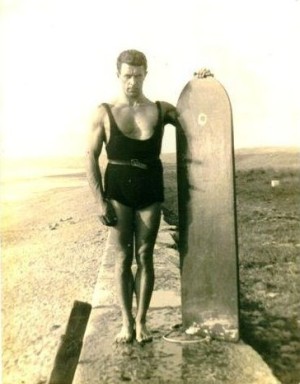
|
|
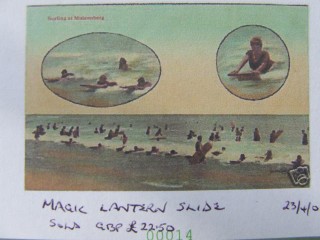
Also see the same scene of bellyboarding in Muizenberg
(False Bay), South Africa, but with slightly different
coloring, in the MyPaipoBoards postcard collection.
Gary Clyst stated that the postcard was dated ca.1908 according to the eBay listing.
|
Photos courtesy of Jeremy Oxenden and Gary Clist.
2. Flippers didn’t become readily available until the
late 1940s. Do
you know if the early Jersey prone surfers were catching waves off
shallow sandbanks or whether they had a technique to catch waves
further out?
Yes, they surfed in deep water. They swam or paddled out with the
boards and they had leashes.
Can you describe the technique involved in swimming
the boards? Were they arm paddled like a surfboard or something
different?
I think they were arm paddled, the boards had some flotation, far more
than the English plywood boards.
What technique is involved in riding these
boards? ?
I only waded out with them as far as I could. I did not think of or see
any one using flippers around 1974. These boards are very flat so a late drop
sent me to the bottom, "Ouch!"
How does surfing one of these wood boards compare with
surfing a fibreglass board?
Well, I have not surfed on one for a very long time but it must been
much easier to surf a modern fiberglassed board with rocker and fins (on the board aka "skegs").
3. Was surfing restricted to St Ouen's Bay?
We can surf in St Brelade's Bay when it is stormy and Oxo lived up the
hill from there, but I do not know if they surfed there.
"The surf hut
was originally built in 1924, and we still have a beach hut there." In
the big group photo are Dot and Ching Martin in the middle and to their right are Pat and Oxo on the end.
These undated photos were from the 1920s and 1930s.
|
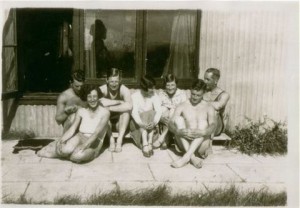
|
|
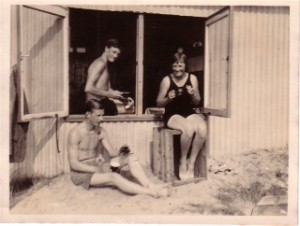
|
Photos courtesy of Jeremy Oxenden.
4. What were the dimensions and construction method of
these 1920s boards? Do you know what wood they were made from?
Teak and some lighter woods. Pine, I think, and
ash (see figure below). The boards were 5
ft. 5 in. long and 14 in. wide; 5 ft. long, 15-3/4 in. at the widest
point, and a tail width of 15-1/4 in.; and, 4 f ft. 3 in. long by 13-1/2 in. wide. All were solid
wood.
Dot Martin on the left, Pat Oxenden (Jeremy's
grandmother) and Ching Martin at the Jersey surf hut, ca. 1920s.
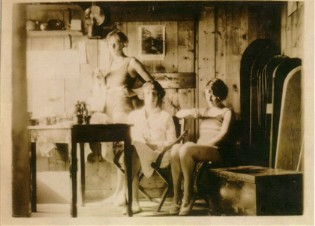
Photo courtesy of Jeremy Oxenden.
5. Who made these boards?
Oxo made them all.
Did he have a background in woodworking?
Oxo was very practical. He built houses.
Can you describe the leash your grandfather used?
Whose idea was this?
A leather belt with a window cord tied at the back too a metal loop at
the tail of the board. I do not know whose idea it was.
6. You’ve written prone surfing started up again after
World War II.
Did it stop during the war or had it stopped earlier? Who started
surfing again?
We were invaded by the German Army so no surfing for 5 years. They all
got back into surfing, but Oxo died in 1948, and his great friend Archie
Mane emigrated to South Africa.
(Left) Beach scene
with bellyboard backrest. (Right) Pat Oxenden at St Ouen's Bay sea wall
late-1940s.
|
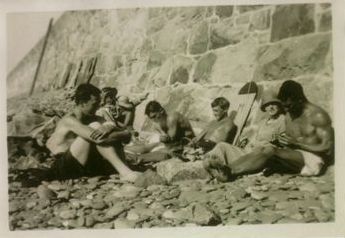
|
|
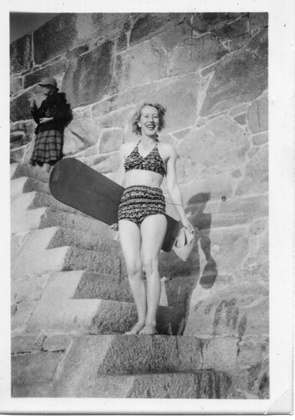
|
Photos courtesy of Jeremy Oxenden.
Was the same style of board ridden?
Yes, but some people had the plywood English boards.
Bellyboards
being surfed in Jersey?
|
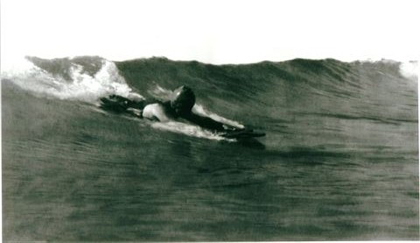
|
|
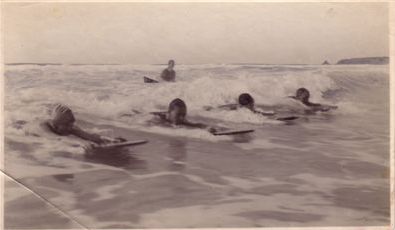
|
Photos courtesy of Jeremy Oxenden.
7. When and where did you start surfing? Who made your
first board and what was it like?
1963, on white foam boards.
By a foam board do you mean an unglassed foam board,
what in Australia we'd call a coolite?
Yes. Some old Jersey Ladies still surf on them. I have surfed on a
friend's Midget Farrelly 9'10' flexi deck with a flexi fin. I have his
book, How to Surf, and just read Anne Trent Moore's book about Buzzy
Trent and his friends, Increments of Fear: The Buzzy Trent Story. I was given a 10'3" Gordon Woods and I have a
Barry Bennett board with one off-centred stringer. There were always
more Australian boards in Jersey than U.S boards in the 1960s.
How did you first get interested in surfing?
My brother and I were taken to the beach when we were very young kids.
8. When did you ride a fibreglass paipo? Who made this
board? What was it like?
Made by John Isaacs of Squire Surfboards about three years ago. It is
a 5'4’’ square-tailed Simmons with 2 fins.
(Left) Jeremy
riding his 5'4'' Squire Surfboard Simmons-shape bellyboard, in 2008. (Right) Jeremy is getting ready for a session at
St Ouen's Bay.
|
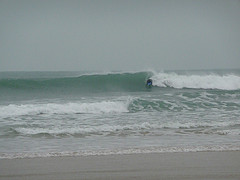
|
|
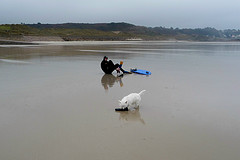
|
Photos taken by Tim Wilson.
What prompted you to get a bellyboard? Whose idea was
it to make a Simmons-style board?
Some friends of mine have vintage U.S belly boards from the 1960s. I
thought I would get a new one and left the design up to John Isaacs.
Jeremy on the
left next to his Squire board; an old board
Jeremy surfed 1974-75; Richard Bates and Archie Maine's board; my
brother's board and my brother Nigel Wray.
|
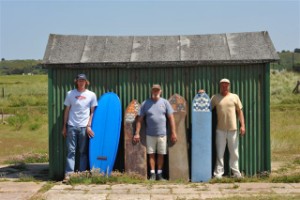
|
|
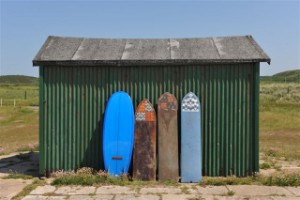
|
Photos by David Ferguson.
9. What other boards have you ridden prone?
One of my Grandfather's five footers and a boogie board, a Morey Boogie Mach 7SS.
Jeremy with Oxo's board on his right and
Archie
Maine's board on his left. Note the "V" notch at the bottom of the
board on the right. This was used for for the metal screw in eye for
the leach (you can still get them from a DIY shop that are galvanised -- see image on the lower right).
|
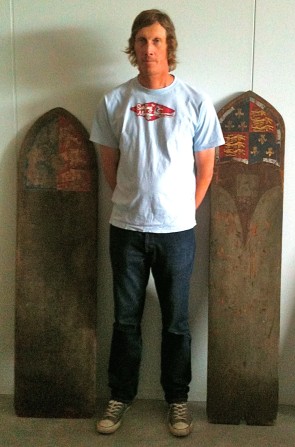 |
|
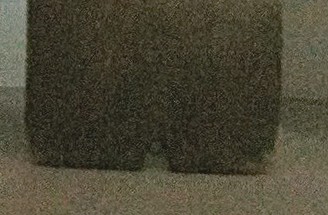
Pictured below is the type of screw used in the tail
v-notch of Oxo's bell boards.
|
Photo by Pete Robinson, Director and founder, Museum of British
Surfing. And stock photo of screw.
|
10. As a stand-up surfer what is the attraction of
riding prone?
Not having to try and stand up with a bad back and it is fun to do
different things such as getting in small tubes. Prone surfers are
more intimate with the waves.
11. What conditions would you prefer to ride prone and
are there
any surfs or waves that stand out from over the years that you rode
prone?
Very strong offshore, windy days with long fast tubes at The Pole Rock
in St Brelade's Bay or in St Ouen's Bay.
Jeremy going left at St Ouen's Bay.
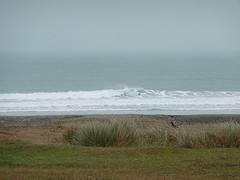
Photo by Tim Wilson.
12. I've read some of your research into surfing
history. Have you
found anything relevant to surfing prone? Anything else of interest
that you have uncovered?
Information from the UK surfing museum. It looks like South
African and Australian soldiers chatted with the Brits and prone
surfing took off around the UK just after World War I.
There is also a passage or two from the Jersey Surfboard Club's recently published book.
An excerpt from the Jersey Surfboard Club book (click on image for entire page).
|
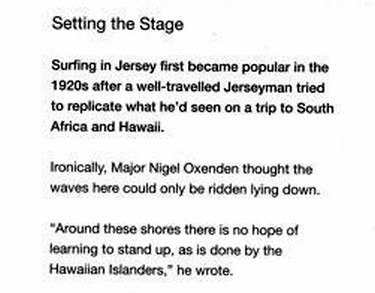
McCarthy, Mick. 2010. Surfing Secrets: Fifty years of Jersey surf stories. Ed. Stuart Abraham. Jersey, UK: Jersey Surfboard Club, page 2.
|
Jeremy noted that despite what is stated in the prelude of the J.S.C.
book lots of his friends must have surfed out in deeper water. |
13. Any other commments?
Surfing is fun no matter how we do it.
|
Note 1: For more information about the service of Major
Nigel Vernon Oxenden MC – GHQ Staff Officer, see the Coleshill House website.
Other
info:
- A book on Jersey surfing including some passages on bellyboarding: McCarthy, Mick. 2010. Surfing Secrets: Fifty years of Jersey surf stories. Ed. Stuart Abraham. Jersey, UK: Jersey Surfboard Club. Available at the Jersey Surfboard Club's website.
- You can find Jeremy Oxenden on Facebook.
|
|